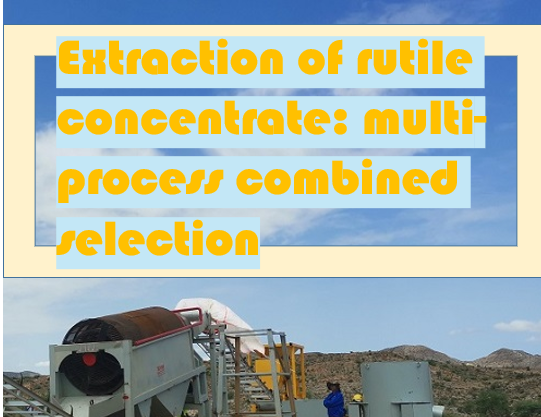Extraction of rutile concentrate—multi-process combined selection
2024-11-08 Xinhai (1550)
2024-11-08 Xinhai (1550)
If you have any questions, please contact us through the following ways, we will give you more and better assistance!

Rutile, as a key titanium-containing mineral, has fine particle size and complex composition of valuable minerals in its ore, which is not much different from the surface properties of the gangue, making its separation process quite challenging.
In the beneficiation process, gravity separation, magnetic separation, electrostatic separation and flotation are often used to separate rutile and associated minerals based on the differences in density, magnetism, conductivity and other aspects. In actual operation, the combined application of multiple beneficiation methods is often required.
In the gravity separation process, the density of rutile is 4.25×103kg/m3, which is somewhat different from the density of its associated gangue minerals such as sphene, beryl, biotite and ilmenite, but it is not enough to obtain high-grade and high-recovery rutile concentrate only through gravity separation. Therefore, gravity separation is usually used for the initial enrichment of rutile and the removal of some low-density minerals or fine mud. Commonly used equipment includes spiral chutes and grooved shaking tables.

In terms of magnetic separation technology, rutile, as a non-magnetic mineral, can be separated from its associated magnetic minerals such as garnet and titanite, as well as weakly magnetic minerals such as hornblende and epidote through a combined process of weak magnetic separation and strong magnetic separation. Initially, a weak magnetic drum magnetic separator is used to remove strong magnetic minerals and protect the high gradient magnetic separator from damage. Commonly used magnetic separation equipment includes Slon vertical ring pulsating high gradient magnetic separator and medium magnetic field drum magnetic separator.
The electrostatic separation process uses the characteristics of rutile as a good conductor, and its resistivity is much lower than that of non-conductor minerals such as silicates and zircons, thereby achieving separation. Studies have shown that adding electrostatic separation to the combined process can increase the TiO2 grade of the concentrate by 1%.
The pickling process is used to remove impurities such as weakly magnetic oxides of iron after conventional beneficiation of rutile ore, further improving the grade of rutile concentrate, and is often used as a link for removing impurities from the concentrate.
Flotation technology is crucial for the selection of fine-grained rutile ore, and is also an effective means to recover rutile from other mineral tailings and improve the comprehensive utilization rate of minerals. For example, using salicylic hydroxamic acid as a collector, rutile can be recovered from copper-molybdenum tailings through the flotation process, and a rutile concentrate with a TiO2 grade of 64.59% and a recovery rate of 77.25% can be obtained.
In the flotation process, fatty acids, arsenic acid, phosphonic acid, and hydroxamic acid are four major types of rutile flotation collectors, each with its own characteristics. Fatty acid collectors have strong flotation ability, but need to be used with gangue inhibitors; arsenic acid collectors selectively capture rutile, but their application is limited due to their high toxicity; phosphonic acid collectors have good selectivity for rutile, but the dosage is large, and they are often mixed with fatty alcohol collectors.
In summary, the beneficiation of rutile is a complex process that requires the comprehensive use of a variety of beneficiation technologies to achieve efficient rutile extraction and the production of high-grade concentrates. With the continuous advancement of beneficiation technology, the beneficiation process of rutile is also being continuously optimized to meet increasingly stringent environmental protection requirements and improve resource utilization.